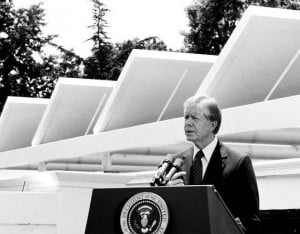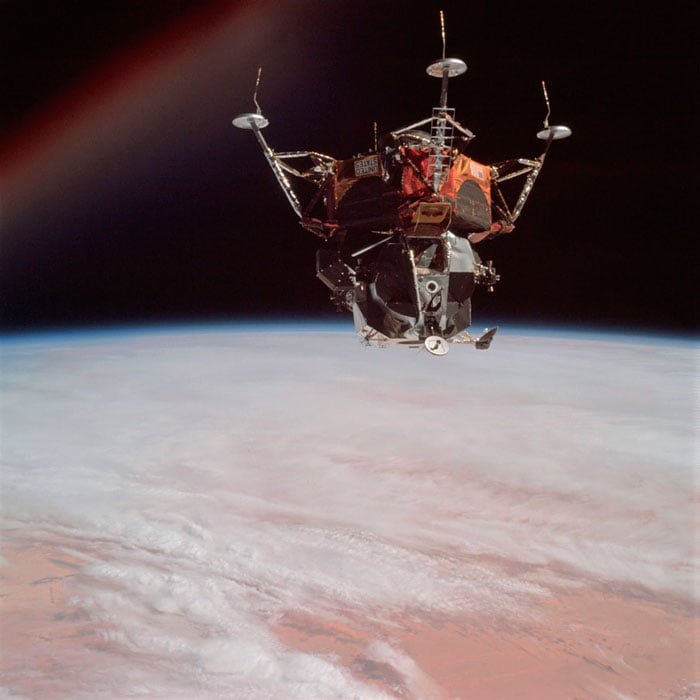The early days of the space race between cold war foes the United States and Soviet Union were set in a world of plenty for the victors of World War II.
After the centrally-planned, collective effort to retool industry for war, an attitude prevailed among American citizens that the most important new technologies would not result from work in the private sector, but would derive from federal initiatives.[1,177]
President Kennedy’s decision committing the nation to sending a man to the Moon before the decade was over was made in a milieu of broadening federal engagement with technology.
This is the thesis put forth by author T.A. Heppenheimer in his book Countdown: The History of Space Flight who noted federal involvement in new technology had been ongoing in the US since President Lincoln built the first transcontinental railroad in the United States “by awarding generous land grants to the builders of the Central Pacific and Union Pacific.” The Panama Canal, Depression-era dams and water projects, and later, President Eisenhower‘s interstate highway system of the mid-50s are all mentioned as historical precedents for federal support of new technologies that serve the public interest.
He mentions jet airliners and commercial nuclear power [the dirty radioactive kind] as technologies created by transforming “major military systems into products that would create new industries in the civilian market”. All of these projects “demonstrated dramatically the scale of activity that Washington was now prepared to pursue.”
Whether for the public good, or, prestige and technological superiority among nations of the world, the services and disservices of these industries are directly related to the systematic mobilization of diverse resources towards a common end.

We march backwards into the future.
—Marshall McLuhan The Medium is the Massage
The public and private collaborations that have generated and delivered energy for over a hundred years have done so at a high cost, environmentally, financially and socially. The patchwork scheme of multiple generations of technology that has provided power thus far, sputtering with age and neglect, is neither efficient or sustainable for our future.
Given the fundamental nature of energy in our lives, federal engagement in the development of clean, safe and efficient energy seems appropriate. But the national undertaking that characterized the Apollo project in the 1960s will not occur in the current climate of segregated interests. Even in a time of crisis, there is no call from the President to participate in a renaissance of invention, for either the public good or the prestige among nations, and there are no contracts forthcoming. Even were that to occur, our population has lost trust in a governing class that has forgotten the integrity of mission and succumbed to compromises with large donors.

The age of Chemical Energy ends with Peak Oil. We have a future with new-energy, or we will have no technological future at all. The inability of federal institutions to move quickly to develop LENR energy technology means private investment bears the burden. Though projects that posses technical risks are “unattractive to Wall Street”,[1] eventually, demand will insist upon it.
But the Rossi Effect, the heightened interest of venture capital in LENR devices since the demonstration of the E-Cat earlier this year, is certain to grow and recent news of one private company’s plans to work with a national lab on reproducing their results as a pre-requisite to funding is a positive sign of cooperation between public and private enterprise.
The ‘expert’ is the man who stays put.
—Marshall McLuhan and Quentin Fiore The Medium is the Massage
Lauded aeronautical engineer and designer of Spaceship 1 and 2, Burt Rutan headed his own spaceship company with a small band of dedicated individuals in the scrubby deserts of Mojave, California and succeeded in creating a new industry of space tourism with the private partnership of Paul Allen, the X-prize Foundation, and Sir Richard Branson. A critic of NASA’s budgetary choices, he saw the future of space in private enterprise.
“Manned space flight is not only for governments to do,” says Rutan. “We proved it can be done by a small company operating with limited resources and a few dozen dedicated employees. The next 25 years will be a wild ride; one that history will note was done for everyone’s benefit.”[3]
We say the same about cold fusion energy. Small, independent companies are right now sacrificing sweat and tears to follow a dream that takes humankind to the next phase of development for all the world’s benefit.
A new energy technology that uses a fuel of water can save the Earth from further degradation and reap rewards beyond our present imagination, but encouragement for these intrepid inventors is needed from the public, both morally and financially, to simulate the “federal involvement” that succeeded so well in landing humans on the Moon.
There are no passengers on Spaceship Earth. We are all crew.
—Marshall McLuhan [5]

Supporting Links:
[1] Countdown A History of Space Flight by T.A. Heppenheimer publisher’s Wiley website.
[2] John F. Kennedy “That is what we have to overcome, that psychological feeling in the world that the United States has reached maturity, that maybe our high noon has passed and that now we are going into the long slow afternoon.” 1960 campaign speech.
[3] Scaled Composites: Burt Rutan About
[4] The Medium is the Massage by Marshall McLuhan reprinted by Gingko Press.
[5] Marshall McLuhan from Famous Quotes.
[6] Happy 100th Birthday Marshall McLuhan! celebrate with McLuhan on Maui July 21rst, 2011

